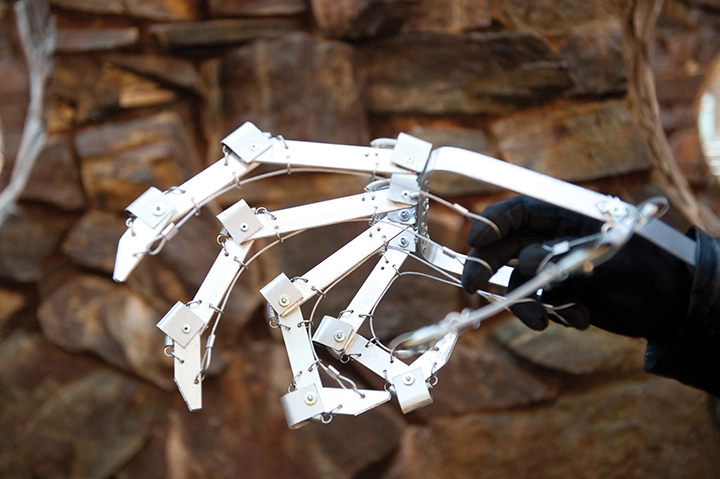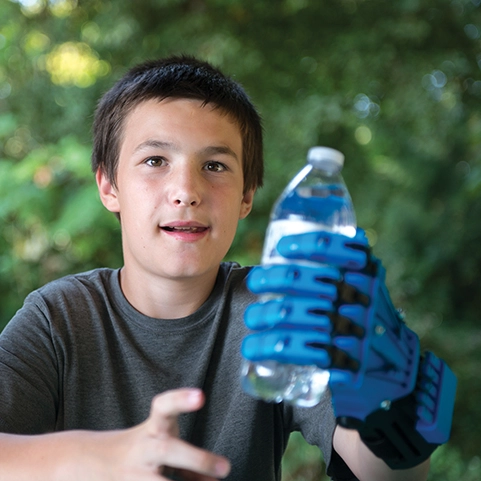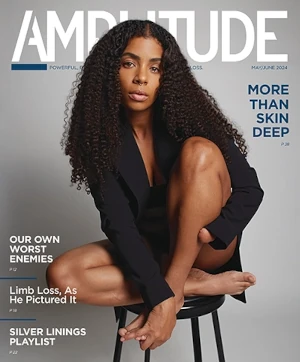By Élan Young

From advanced software, to improved battery life, to more power-efficient microprocessors, advances in prosthetic devices provide amputees significantly greater choice today than they had even five years ago. Some have called it a new era of human bionics. The advent of the 3D-printed prosthesis has added a much-discussed dimension to the world of prosthetic care: access. Yet, it’s important for amputees to understand what 3D-printed prostheses can provide as well as their limitations.
Major news outlets have reported about the promise of 3D printing since 3D printers first became commercially available in 2009, and even more so since 2012 when they were introduced to the entry-level market. In that time, many stories have focused specifically on 3D-printed prostheses. These stories usually follow a positive narrative about helping children or people in developing countries gain a level of freedom—whether through increased physical ability or increased social and self-acceptance. Additionally, there is a strong focus on bringing hope to those who can’t afford any prosthetic care.
However, as the technology has created opportunities, it has also raised some red flags. Unfortunately, not all of the 3D printing groups that make prosthetic devices have been compliant with U.S. Food and Drug Administration (FDA) regulations and/or federal or state licensure and accreditation requirements. Currently, there are only 15 states in which it is illegal to provide a prosthetic or orthotic device without a license. Additionally, those who are providing 3D-printed prostheses are usually not calling them prostheses, but rather limbs. Lastly, they are not selling the devices, but giving away the open-source designs to allow volunteers to print them. Any cost involved is for materials and is nominal.

Chris Baschuk, MPO, CPO, LP, at Handspring Clinical Services, a clinic specializing in upper-limb prosthetic rehabilitation, balks at the notion that 3D-printed limbs are not medical devices, and he doesn’t believe that donating the designs to people changes the matter. “If I made a prosthesis in my clinic and donated it to a patient without charging for it, is it still a prosthesis or is [it] now magically something else?” he asks rhetorically. “I would say that it’s still a prosthesis and therefore an FDA-regulated medical device. All medical devices, including 3D-printed prostheses and components, independent of whether or not they are sold or donated, should be held to the same FDA standards and guidelines for medical devices. The reasons those standards exist are for patient safety.”
Others in the orthotic and prosthetic community have weighed in on this and other concerns that have come about in the wake of increased attention on 3D-printed prostheses. In February 2015, the American Orthotic & Prosthetic Association (AOPA) released a statement to bring awareness about misinformation in the media. For example, it clarified that upper-limb prostheses cost closer to $1,500-$8,000, much less than the $40,000-plus cost claimed in some news reports. While that is still higher than the $50 it might cost for the supplies for a 3D-printed device, cost is certainly not the only—or the most important—factor to consider.
3D Manufacturing
3D printing is a manufacturing technology that operates in a unique way. Its features enable the creation of complex devices at a much lower cost than other traditional manufacturing methods, and there are a wide variety of methods for printing. Fused deposition modeling is one type of additive manufacturing used in the creation of plastic limbs. Plastic is heated and dispensed through a hot nozzle, much like a glue gun. The model is then built layer by layer. This method of printing requires strict control of the surrounding temperature and humidity, as these two variables will inevitably affect the structural integrity of the device. The rate at which the plastic cools greatly affects its overall quality. If it cools too quickly, the model becomes brittle. If it doesn’t cool quickly enough, the shape can deform.

Additionally, if a design has voids that require infill, it can affect the overall strength of those areas. However, there is no standard about how strong that infill needs to be. Many prosthetists would like to see 3D-printed devices tested at a specific level of infill. If there’s going to be an allowed variance, then those models need to be tested at their varying levels of infill.
Peter Binkley of e-NABLE, a web-based community of volunteers who are using their 3D printers, design skills, and personal time to create free 3D-printed prosthetic hands for those in need, explains the limits of the technology: “One of the limitations of 3D printing is that the components it produces are usually not nearly as strong as injection-molded parts,” he says. “Even less so with less-than-optimal print settings on low-cost, [and] in some cases homemade, printers.” This is why his group does not engage in producing lower-limb devices, which need to be able to bear a lot of weight. “With an upper-limb device, failure usually means that the user drops the object being carried,” he says. “Failure of a lower-limb device usually means that the user falls down, which can be much more dangerous.”
Recently, the FDA released a draft of guidelines about what sort of things need to be addressed when using additive manufacturing to create medical devices, but until those guidelines are finalized and implemented, there will not be set standards for 3D-printed prostheses.
Safety First
One way to think about 3D-printed prostheses is that they cut out the middlemen (the prosthetist and the manufacturer) and thereby connect users directly with the devices they need. The problem with this is that prosthetists are trained medical professionals. They’ve earned licenses that take years of education and apprenticeships, and even then they must continue to learn and grow with the profession to further develop their knowledge and skills. To cut them out of the equation means the amputee is forgoing any medical expertise in the creation or fit of what is a medical device. When a device malfunctions or doesn’t fit properly, it might not be a matter of life and death, but it still might be a matter of safety and well-being. There are three classifications for medical devices, with Class I including things like tongue depressors and Class III including high-end technology such as pacemakers. Prosthetic devices are considered Class II medical devices.

Binkley says, “These devices don’t totally remove prosthetists from the process. Especially with traumatic and disease-related amputations, we recommend working under the advice of a clinician.” e-NABLE’s devices are meant primarily for those born with limb differences, and when the user’s body changes, some designs are adjustable. “But when a new device is needed, we take new photos and follow the procedure for determining device scale,” he says. “If your amputation occurred after birth, you should check with a prosthetist to make sure you are eligible for a 3D-printed prosthesis.”
Baschuk is helping to educate people about what 3D printing is—a manufacturing technology—and what it isn’t—a prosthetic panacea. While he does speak to the potential safety concerns and functional limitations of 3D-printed devices, he doesn’t think the manufacturing technology is inherently bad but that it needs to be understood for what it is and applied appropriately under FDA guidelines. He grants that the likelihood that someone would be physically harmed by a 3D-printed, body-powered prostheses is low. However, he’s become very concerned about the addition of electronic components in some of these devices. “I’m concerned about the type of batteries they are using,” he says, and he’s worried about accidents similar to the viral video of a hoverboard catching fire last December. “The prosthesis might look really cool, but the patient using it may not know about the risk of these lithium-ion and lithium-polymer batteries catching fire or causing electric shock, as they are not designed or certified for medical electronics.”
The Future is Now
For now, it’s business as usual for the e-NABLE community as it continues to improve the designs it offers. “Among e-NABLE designers, our best-developed devices are wrist-powered, for a user with a wrist but no digits,” says Binkley. “We’ve made good progress in elbow-powered devices for trans-radial amputees and wrist disarticulations, and we’re developing a device for transradial amputees, which attaches to a traditional socket.”

Meanwhile, Baschuk continues to educate people about the reality that he sees as a prosthetist. “The maker movement and 3D printing has created a massive influx of individuals who have great intentions for providing care to upper-limb amputees. But, just like the certified prosthetist who only sees one upper-limb amputee every 18 months because they are a small portion of the amputee population, they are amateurs when it comes to understanding the complexities of creating a properly fitting upper-limb prosthetic socket.” His concern is that a patient may seek out a 3D-printed prosthesis because it is less expensive and not have a long-term positive outcome, which will turn him or her off to using a prosthesis in general. The net effect would be a potential increase in the rejection rate for upper-limb prostheses. Baschuk explains if that same person had sought care from a certified prosthetist who has more experience in upper-limb prosthetics, the probability and likelihood of a successful functional outcome would be much higher.
Baschuk’s main point is boiled down to something everyone’s heard: “In the end, you get what you pay for.”
The reality is, like many emerging technologies, an area of grey exists on the cutting edge. Even as the devices continue to help many people, there is much left to do to make sure they meet the same requirements imposed on traditional prosthetic devices and they earn FDA approval.



